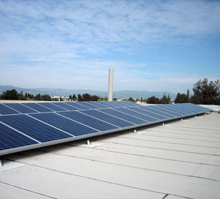
Device Could Drive Down Solarís Cost

As solar panel manufacturers try to harvest more of the sun’s energy for less, they face increasingly diminishing returns. At roughly $1 per watt, the cost of solar modules now represents less than a third of the total cost of commercial solar installations. To cut the total cost of solar power—currently $3.00 to $3.50 per watt—bigger gains will have to come from improvements in the power electronics, wiring, and mounting systems required for solar installations.
ArrayPower, a startup based in Sunnyvale, California, has developed a new type of solar inverter—the device that converts direct current (DC) power produced by solar panels to grid-ready, alternating current (AC) electricity—that it claims could significantly reduce the cost of solar power. The company says its “sequenced inverter” will reduce the cost of commercial solar by 35 cents per watt, or more than 10 percent, by lowering capital costs, simplifying installation, and increasing output.
Large-scale solar installations currently use either a single “central” inverter or a number of “string” inverters to convert power from groups of panels strung together in series. Both approaches, however, suffer from low efficiencies because of the way the panels are connected. In either scenario, if one panel is damaged or shaded from the sun, the system’s entire output is diminished to the level of its lowest-producing panel.
ArrayPower seeks to maximize power output through a new type of inverter mounted to each panel. The device is similar to microinverters now used in residential solar installations. By converting DC to AC power at each module, microinverters maximize the power output of each module, thereby increasing system output by roughly 3 percent to 10 percent.
Microinverters are typically more expensive because they require sophisticated electronics to filter and smooth the alternating current coming out of each inverter. A major cost is an electrolytic capacitor, essentially a chemical battery that stores energy for short bursts, allowing the inverter to send out pulses of electricity that create an alternating current. Further, microinverters typically only yield single-phase AC electricity, an electric current that is suited for residential use but not commercial or utility use.
ArrayPower’s distributed inverters attach to the back of each panel. They use diodes and transistors to first boost the direct current coming off the panel from 60 volts to the 208 volts used on the grid. A copper coil inductor then briefly stores the current, allowing the device to emit discrete pulses of alternating current. The pulses are combined with those from a minimum of three other panels to form grid-quality alternating current.
“The real novelty here is that the system, rather than the individual device, is doing the filtering and the smoothing,” says Nick Cravalho, ArrayPower’s vice president of business development.
Another key advance, Cravalho says, is the creation of three-phase rather than single-phase current. A three-phase signal combines three individual waves of alternating current of the same frequency that reach their peak voltage at different times. By emitting pulses for a sequence of three closely timed waves instead of a single wave, ArrayPower’s sequenced inverter stores smaller amounts of electricity for shorter durations. As a result, the company can use inductors rather than capacitors for energy storage, thereby reducing cost and increasing the life expectancy of the device.
“The electronics look very simple,” says Daniel Kammen, director of the Renewable and Appropriate Energy Laboratory at the University of California, Berkeley. Kammen is not affiliated with the company. “It’s basically a series of wave amplifiers working in concert with each other, allowing for devices that should be very robust.”
Kammen says that while the technology looks promising, longer field trials will be needed to prove the long-term durability of the devices.
ArrayPower has partnered with Canadian Solar, one of the world’s largest solar panel manufacturers, to integrate the inverters into the company’s crystalline panels. The companies have conducted field tests of the integrated panels for seven months and Canadian Solar says it plans to begin shipping the combined panel plus inverter units this quarter.
